The Asus ROG Swift PG27UQ G-SYNC HDR Monitor Review: Gaming With All The Bells and Whistles
by Nate Oh on October 2, 2018 10:00 AM EST- Posted in
- Monitors
- Displays
- Asus
- NVIDIA
- G-Sync
- PG27UQ
- ROG Swift PG27UQ
- G-Sync HDR
Physical Design and Features
Starting with appearances, the design of the PG27UQ is, to put colloquially, quite thick. This would typically be an area where different companies can distinguish between similar products, in this case meaning Asus and Acer, but the dimensions are a consequence of the AUO LCD/backlight unit, the G-Sync HDR module, and HSF assembly.
And yes, a heatsink and fan. Topping the bulkness off is the aforementioned active cooling with the fan, located behind the stand/VESA mount point. The fan's behavior is not really documented, but it runs during standby and sometimes when the monitor is powered off - the latter behavior had me slightly confused on first use, as the fan spun up once I plugged in the monitor. Thankfully, the noise levels are low enough that it should only be a concern for fanless/silent configurations.
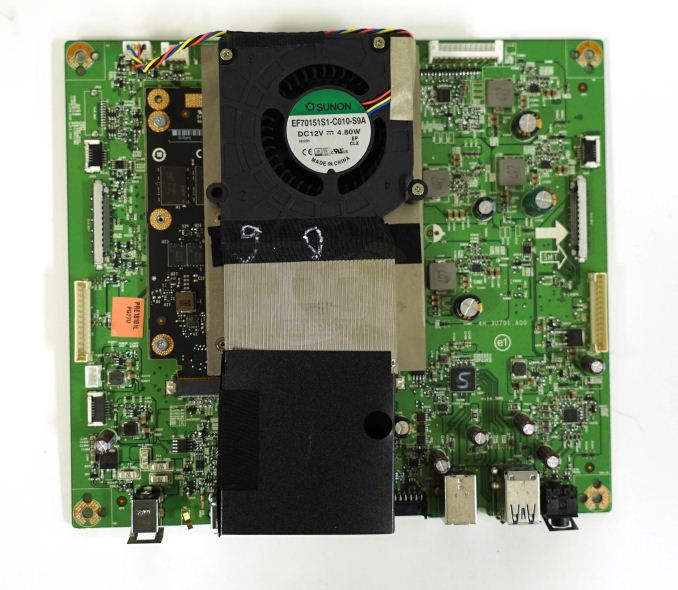
PCPerspective's photo of the FPGA module and fan
A teardown by PCPer revealed an Altera Arria 10 GX 480 FPGA with 3GB DDR4-2400 RAM, a substantial upgrade from the Altera Arria V GX FPGA with 768MB DDR3L of the original G-Sync module. NVIDIA stated that, like previous iterations, the module does not replace the TCON and does not support VESA DSC. The latter has been suggested as a solution to the bandwidth limitations of combined high res/high refresh/HDR, and we know that DisplayPort 1.4 includes the DSC standard. Implementing DSC for G-Sync may or may not add latency, but NVIDIA probably explored that option before going with the current implementation of chroma subsampling past 98Hz.
More interestingly, NVIDIA also mentioned that the G-Sync HDR module uses eDP to interface with the LCD panel, as opposed to the first generation’s LVDS, which is an aged standard nowadays. In general, eDP provides higher bandwidth, requiring fewer PCB traces and signal wires overall, and so consumes less power. Except in this case, the overall power usage and/or heat generation requires a blower fan.
It’s been reported that the 27-inch panel will come in a non-HDR variant without the FALD backlight, but the price reduction is harder to guess, since the G-Sync HDR module and quantum dot film would likely still be used. The panel will presumably have an eDP interface, which wouldn’t be compatible with the LVDS-only capability of the first generation G-Sync modules. At the least, there likely wouldn’t be a need for active cooling anymore.
So in contrast with the modern trend of smaller screen borders, the PG27UQ bezels are noticeable at around 15mm at the sides and around 20mm on the top and bottom. The three-point stand is large and the unit as a whole is on the heavier side, just a little over 20 pounds. That stand actually allows for underside LEDs, which can project a logo on the desk below, and the monitor comes with customizable blank plastic covers for this purpose. This falls under the "LIGHT IN MOTION" OSD, and a separate "Aura RGB" option governs LEDs for the ROG logo at the back of the stand. Alternatively, Aura Sync can be enabled to control the "Aura RBG" lighting.
Similarly, the ROG logo can be projected rearwards by the "ROG Light Signal," the last bit in the monitor's bling kit. The power LED also does turn red, but this is to indicate that the monitor is in G-Sync model; it is white during standard operation and amber during standby.
Also at the top of the monitor is an ambient light sensor, which is used with auto-adjusting SDR brightness ('Auto SDR Brightness') and blackness (Auto Black Level) settings in the OSD.
Connectivity is as minimal as it gets without being a big issue: 1 x DisplayPort 1.4, 1 HDMI 2.0 port, an audio jack, and a 2-port USB 3.0 hub. By standards of a premium monitor, it’s certainly not ideal; even if the panel specifications and features are the main attraction over connectivity, the $2000 price point hardly suggests minimal connections. The configuration is identical with Acer's X27 so I'm not sure if there was much Asus could do, unless the reasoning was primarily about margins (if so, then it might indicate that development/panel/module expenses are higher).
The stand and mount combine to offer a good range of adjustment options.
In terms of the on-screen display (OSD), the PG27UQ comes with several SDR picture mode presets called 'GameVisual' as it uses GameVisual Video Intelligence. The modes are as follows:
- Racing (default): intended for input lag reduction
- Scenery: intended for more constrast gradations. Also sets monitor to 100% brightness and locks gamma and Dark Boost (auto gamma curve adjustment)
- Cinema: intended for saturated and cool colors. Also sets monitor to 'Cool' color temperature and locks gamma and Dark Boost
- RTS/RPG: intended to enhance constrast sharpness and color saturation. Also sets gamma to 2.4 and Dark Boost to Level 1
- FPS: intended for higher constrast. Also sets Level 3 Dark Boost
- sRGB: intended for viewing photos and graphics on PCs. Also locks color temperature, brightness, contrast, and gamma
Switching to HDR mode disables GameVisual, and locks gamma, dark boost, variable backlight, and Auto SDR Brightness.
Meanwhile, a separate 'GamePlus' button brings up options for gaming-oriented OSD overlays: crosshair, timer, FPS counter, and screen alignment markers for multi-monitor setup.


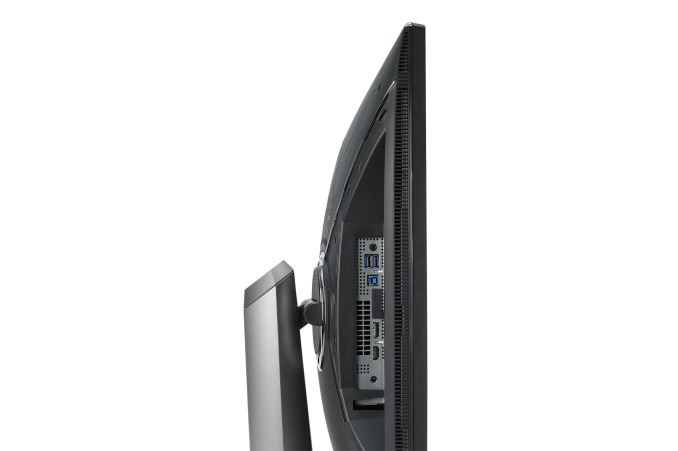
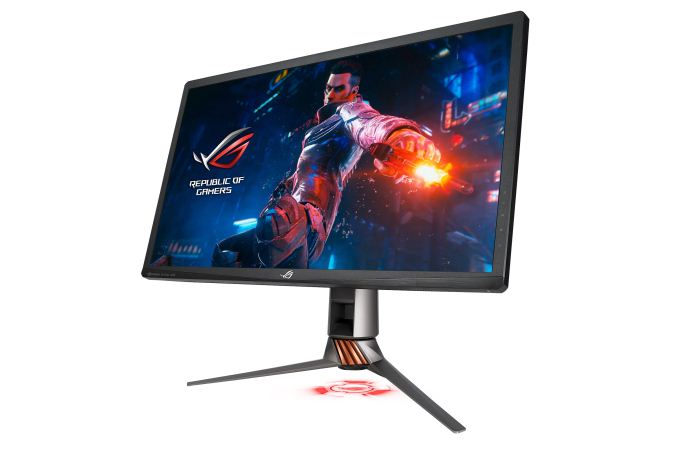

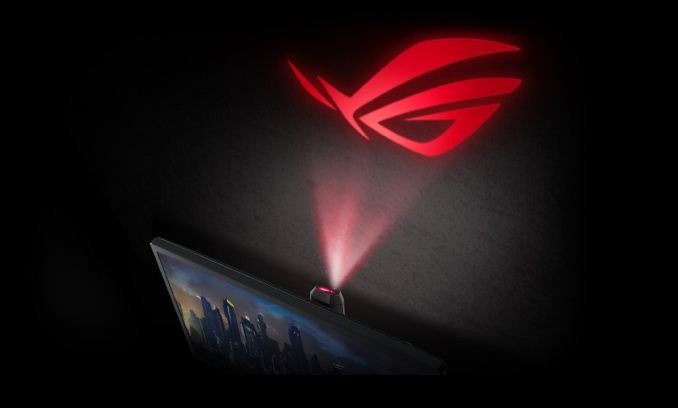
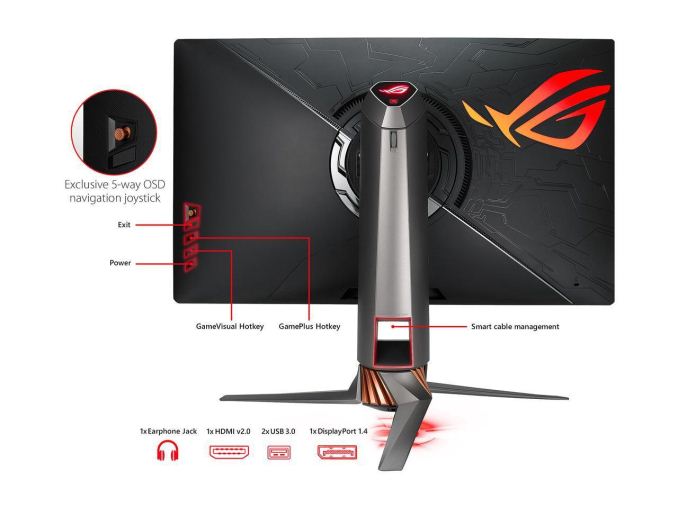

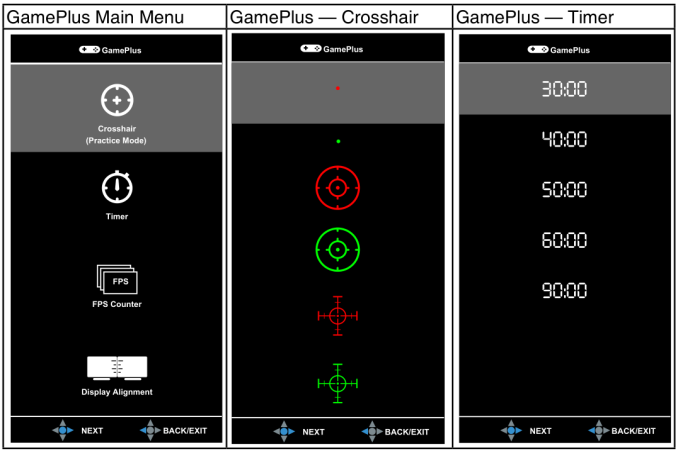








91 Comments
View All Comments
FreckledTrout - Tuesday, October 2, 2018 - link
AUO have stated it lands this fall so should be very soon. They made it sound like they will have a shipping monitor by the end of 2018 albeit who really knows but im sure its under 1 year away at this point.Can Google: "AUO Expects to Launch Mini LED Gaming Monitor in 2H18"
imaheadcase - Wednesday, October 3, 2018 - link
Don't keep hopes hope, remember this monitor in this very review was delayed 6+ monthsLolimaster - Tuesday, October 2, 2018 - link
384 zones is just CRAP, you only find that number of zones on low end cheapo TV's with FALD just o be a bit more "premium". For that price is should have 1000 AT LEAST.Seems we will need to wait for LCD with minileds to actually start seeing monitors with 5000+zones.
know of fence - Tuesday, October 2, 2018 - link
Consoles started to push that 4K / HDR nonsense and now the monopoly provides a monitor to match for the more money than sense crowd. The obscure but sensible strobing backlight / ULMB got sacrificed for the blasted buzzwords and Gsync. Is it because the panel is barely fast enough for Gsync or is it a general shift in direction, doubling down on proprietary G-stink and the ridiculously superfluous 4K native. Is it because with failing VR, high frame rates are off the table completely?Is there any mention on how 1920x1080 looks on that monitor (too bad), because the pixel density is decidedly useless and non standard. But scaled down to half it could be 81.5 ppi and this thing can actually be used to read text.
godrilla - Tuesday, October 2, 2018 - link
$1799 at micr1 fyi!godrilla - Tuesday, October 2, 2018 - link
Microcenter*Hectandan - Tuesday, October 2, 2018 - link
"the most desired and visible aspects of modern gaming monitors: ultra high resolution (4K)"No it's not. At least on Windows where UI scaling still sucks. At least on "slow" graphics card like 2080 Ti where 4K doesn't run 144fps. And 4K monitors can't do 1440p natively, so a huge deal breaker.
Zan Lynx - Wednesday, October 3, 2018 - link
If you had a graphics card that could always run 144 Hz then you would have no need for GSync.imaheadcase - Wednesday, October 3, 2018 - link
Why would you care about scaling for gaming? Besides, plenty of 3rd party apps to correct windows bullshit.Hectandan - Thursday, October 4, 2018 - link
No I don't care about scaling in games, but I do care about 144fps in games. Only possible in 4K with SLI 2080 Ti and good game SLI support. Plenty of games don't.Also plenty of 3rd party apps not correcting Windows bullshit, and I gain no extra working space if I do scale.
Simply too many downsides and too little benefit.